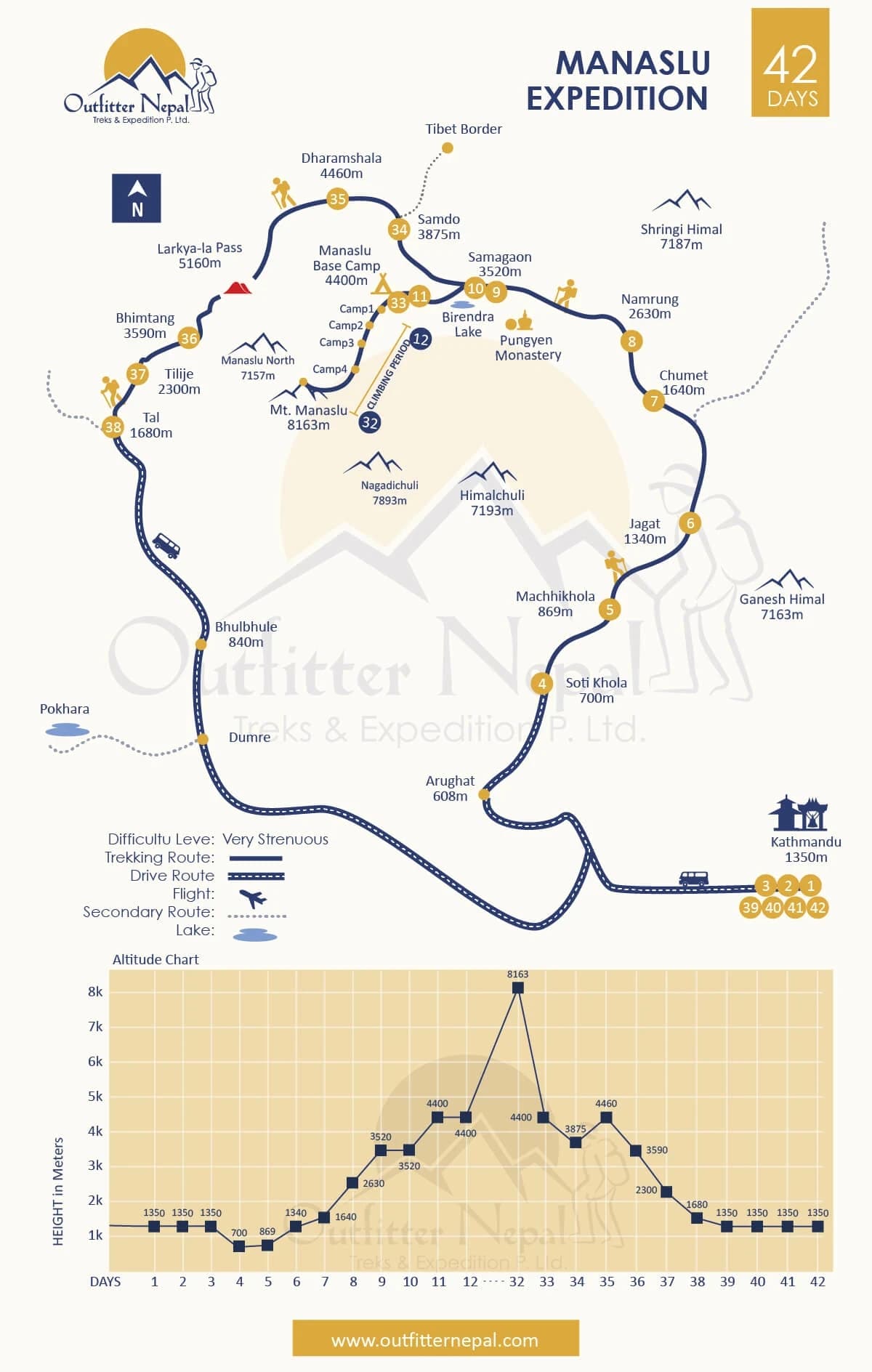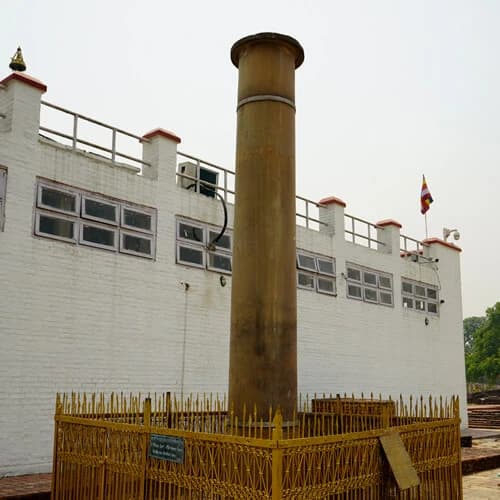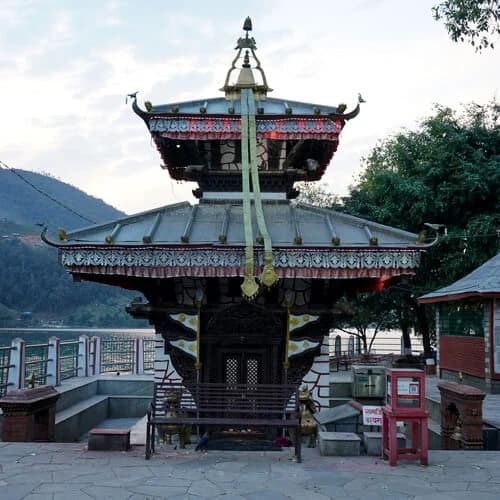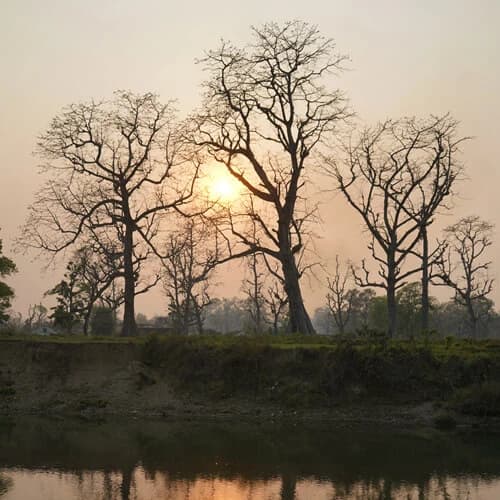Mount Manaslu Expedition in Autumn Overview
The Manaslu region's expedition and trekking routes are among the popular climbing and trekking destinations in Nepal. Thousands of people flock to this territory to traverse the untrodden trails and climb Mount Manaslu every year. The Manaslu Circuit Trek is one of the most popular trekking routes in this vicinity.
Mt. Manaslu is a challenging summit that requires skilled climbers who have already reached mountain summits higher than 7000 meters. This is one of the toughest climbs of all the 14 eight-thousanders'. If you tackle Mt. Manaslu, you will gain more climbing experience for the upcoming 8-thousander climbs. Ralph Waldo Emerson says, "It's not the destination; it's the journey." This is especially true of the Manaslu trip since, without the struggle to get there, you might not fully appreciate the adrenaline rush and thrill you feel when you finally arrive.
As you journey through the emerald-green forest, you can see a variety of unusual plant and animal species like the Himalayan Blue Pine, Rhododendron, Red Pandas, and Snow Leopard. Gurung, Nubri, and Tsum people make up the majority of the population in this region. You get to enjoy these people's gracious hospitality.
The Manaslu expedition can reach the summit by taking a variety of interesting routes from Manaslu Base Camp (4,700m). The traditional approach, which was also used by the initial Japanese expedition up the Northeast Face in 1956, is the most popular. Despite not being the most difficult mountain to climb, Mt. Manaslu demands more technical expertise than Shishapangma or Cho Oyu. Avalanche risk is increased by the Base Camp's low elevation.
The rate of successful ascent for Manaslu is higher. Since you'll be climbing above 4000 meters, you must be cautious about altitude sickness. Climbers must therefore be in good physical and mental health. You will go through the picturesque countryside, woodlands, and valleys during the Manaslu expedition. You can see other breathtaking peaks along the trail, including Himalchuli, Saula, Langpo, Ngadi Chuli, and many others.
Beginning with a bus ride from Kathmandu to Soti Khola and a walk through the Budi Gandaki Valley to Sama Gaun, the Manaslu Expedition in Autumn ascends the northeast ridge. Several icy slopes and an arête must be negotiated before reaching the peak. An arête might be characterized as a skinny saddle or ridge. The next step is a challenging ascent to the summit, where you will undoubtedly get some of the most beautiful views of the Himalayas you can imagine.
Join Outfitter Nepal's autumn Manaslu expedition for the experience of a lifetime! We are currently accepting reservations for our Manaslu Expedition in 2024 and 2025. As part of our Autumn Expedition, you will be accompanied by our knowledgeable mountaineering Sherpas to the top of the difficult Mount Manaslu from the Nepal side. Your safety is our top priority, and we have carefully designed the autumn itinerary with that in mind.
Best Features of the Manaslu Autumn Expedition
- Ascending the summit of the eighth-highest mountain peak in the world
- Hiking a challenging trail in the Manaslu region to get to the base camp
- One of the toughest summits in the Himalayas for experienced mountaineers
- Observing a range of meteorological and ecological changes in a single Himalayan visit
- Gaining broad cultural exposure in the lowest parts of the excursion
A Brief History of the Manaslu Expedition
Manaslu was first formally surveyed in 1952 by a group of Japanese reconnaissance missions that traveled to Nepal after HW Tillman and Jimmy Roberts photographed it in 1950 while on a hike. The following year (1953), a team of 15 Japanese climbers under the direction of Y. Mita attempted to ascend the mountain from its eastern side. They erected a base camp at Samagaon, but they were unable to reach the top. In this first effort, 3 climbers ascended the northeast face to a height of 7,750 meters (25,430 ft) before turning back.
In 1954, a Japanese expedition that was returning to the Budi Gandaki path to climb the peak was confronted by an enraged group of locals at the Samagaon camp. The people thought that prior explorations had angered the gods, causing the avalanches that destroyed the Pung-Nguyen Monastery and took the lives of 18 citizens. The crew hastily made their way to Ganesh Himal. A significant contribution was made to repair the monastery to quell local anger. This benevolent act did not, however, reduce the prevailing attitude of suspicion against Japanese incursions.
In spite of the odds, Toshio Imanishi (of Japan) and Gyalzen Norbu (of the Sherpa nation) succeeded in climbing Manaslu for the first time on May 9, 1956. The crew was led by Yuko Maki, also known as Aritsune Maki. Even the 1956 expedition ran into the problem of the irritate townspeople. As a result, the subsequent Japanese trip was postponed until 1971, when a different crew finally made it to the summit. A South Korean Expedition immediately followed the triumph.
Five climbers and ten Sherpas perished in an avalanche in April 1972 as they completed the fourth successful ascent of Mount Manaslu by ascending from Marshyandi Valley. Charlie Mace made the first ascent from America in 1997. According to legend, Manaslu has always been considered a Japanese peak, similar to how the British view Everest as their mountain.
Is Mt Manaslu Expedition in Autumn safe?
Manaslu's history was primarily composed of sincere, modest private expeditions until about five years ago. Being one of the 14 8,000-meter summits on the planet, it was a sought-after goal for fervent climbers seeking a difficult Himalayan summit. The mountain is not very tall by Himalayan standards and is above one of the major trekking routes. As history would imply, however, short does not necessarily mean secure.
Under the correct conditions, the peak, which is the fifth-most-climbed eight-thousander in terms of summits, can be easily scaled. However, compared to other summits, it has a death rate of around 35%. Until you really reach the top or thoroughly investigate it, you have no idea what Manaslu will throw at you. So, it's necessary to prepare well before you attempt the summit.
What's most challenging about the Manaslu Autumn expedition?
At the top, your stamina and consciousness will be put to the test. With appropriate pre-trip acclimatization, enough hydration, and suitable food, you should be able to adjust to the altitude, even if breathing will be challenging. The oxygen content at such great height is really low.
After leaving base camp, the real alpine challenge begins, mostly involving climbing up steep ice and snow surfaces. The climbers set up camp and stage at the base camp, where they would spend the next few days getting ready to tackle Manaslu. Once you leave one camp and head to another, Manaslu has some of the steepest and longest climbs. The climbing trail is located in a fairly exposed area. Thus, there are significant hazards of avalanches and crevasses opening there. The route is difficult and prone to avalanches due to the slippery slopes underneath the heavy covering of snow.
How can I prepare myself for the Manaslu expedition in autumn?
Manaslu's expedition is by no means easy. As a result, we require everyone interested in the challenge to have successfully completed at least one other high-altitude climb at a height of 7000 meters or more anywhere in the world. Making a simulation that involves climbing ladders to cross actual mountain crevasses for training purposes is fairly challenging. Your top focus should be endurance, strength, and core training. Any type of cardiovascular exercise is advised, including long-distance jogging (10–20 km) 3-4 times per week, cycling for an hour or two, and hiking uphill with 15-20 kg of weight. For preparation, we also suggest doing endurance training activities. Begin the planning at least five or six months before you depart for your expedition.
Why choose Outfitter Nepal for your Manaslu Autumn Expedition?
The success of any expedition hinges on having a carefully thought-out schedule and the best logistics, both of which we provide. With our outstanding service, we are dedicated to preserving the safety and efficacy of the mission.
We place a lot of emphasis on maintaining a small group to make it easier for everyone to communicate and cooperate. Mountain guides who are among the best in their field and have climbed Manaslu several times will be in charge of leading you. They have a lot of experience and training. Our climbing approach is in line with the many summits that our guides, Sherpas, and support staff have successfully reached over the years. In the end, you'd have a joyful and memorable experience with us.
How much does the Manaslu Expedition cost in autumn?
A number of parameters determine the cost of the Manaslu Expedition. Various trekking and mountaineering organizations base their pricing on the services they offer. Since there is no intermediary commission when booking with a locally based company, local companies offer better deals than foreign companies. The size of the group also influences the cost. If you're traveling with a larger group, you may be eligible for group discounts. We've chosen expedition costs after careful consideration that is both inexpensive for you and beneficial for us. The price for the Autumn Manaslu Expedition at Outfitter Nepal starts at US$19000.
Manaslu Acclimatization Camps
The safest and most popular approach to the summit on the Manaslu Expedition is via the northeast face. Between Base Camp and the summit, this route has 4 separate campsites, labeled Camp 1, Camp 2, Camp 3, and Camp 4. Base Camp (4800 m)
Located on a rocky moraine, Manaslu Base Camp offers incredibly beautiful Himalayan views. The climbers spend the majority of their time in base camp practicing and getting ready for the ascent. For roughly 20 days, this will be your place of stay. Aside from your own tent, you'll also get a dining tent, a shower tent, a bathroom tent, and a communal space. The mountain Sherpa will teach you the fundamentals of climbing as well as the skills needed to complete the summit climb.
Camp 1 (5600 m)
As you move from the base camp toward the summit of Manaslu, Camp 1 is your first stop. The camp is divided into two sections: Lower Camp 1 and Upper Base 1, and it is located at a height of approximately 5600 meters. Climbers must negotiate treacherous uphill terrain that crosses moraines and glaciers with crevasses in order to get to Camp 1.
Camp 2 (6300 m)
Camp 2 is located at a height of 6300 meters. Crevasses and icefalls line the path from Camp 1 to Camp 2, with slightly inclined snow slopes in the lower levels and a brief steep slope in the middle. The climbers must scale 100 meters of vertical, 50–60 degree-angled walls. Although it is the most challenging part of the climb, after you reach Camp 2, you'll get to see yet another breathtaking Himalayan peak view. Mountains appear to be right next to you from this vantage point.
Camp 3 (6800 m)
By climbing on icy slopes from Camp 2 for only 4 to 5 hours, Camp 3 brings you even closer to your goal. Without any ladder crossings, the ascent from Camp 2 to Camp 3 is regarded as the quickest and easiest. But when jumping off the half-meter-long crevasses, one must be cautious.
Camp 4 (7300 m)
The final campground before the summit, Camp 4, is located at 7300 meters, or around 800 meters below the peak. One must climb a steep slope of between 55 and 60 degrees consisting of an ice layer that is completely coated in snow to reach Camp 4. The vista is absolutely breathtaking from here.





